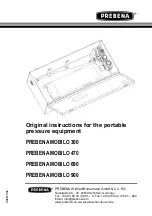
13-10-615 Page 55
In many instances, the cooling water supply for the heat exchanger will contain impurities in solution
and/or suspension. These substances can cause scale formation, corrosion and plugging of any water-
cooled heat exchanger equipment. Disregarding the possibility that one or more of these conditions exist
may result in increased maintenance and operation expense, reduced equipment life and emergency
shutdown. It is strongly recommended that a reputable, local water treatment concern be engaged to
establish the corrosion, scale forming and fouling tendency of the cooling water and take steps necessary
to remedy the situation if a problem does exist. The need for water treatment may involve only filtration
(screening) to remove debris, sand and/or salt in the cooling water supply. However, chemical treatment
methods may be necessary in certain instances to inhibit corrosion and/or remove dissolved solids, to
alter the water’s tendency to form scale deposits, or prevent the growth of microorganisms. The normal
maintenance program for the unit should also include periodic cleaning of the tubes (water side) of the
heat exchanger to remove deposits which enhance fouling and corrosion.
Hex head zinc anodes are used in the return bonnet (opposite end to the water pipe connections) of heat
exchangers to provide internal water system corrosion protection. These anodes should be inspected
periodically and replaced when the zinc has been reduced to about 1/2 inch (13mm) in length.
Figure 5-10 – WATER CONTROL VALVE
WATER FLOW CONTROL VALVE FOR HEAT
EXCHANGER (Optional Equipment)
(Figure 5-10) -
The water flow control valve is adjustable to compensate for varying water inlet temperatures and
pressures and is to be mounted in the water outlet line after the oil cooler (
Figure 5-3
, page 43). Use the
compressor discharge air temperature gauge on the instrument panel in setting the flow control valve.
The compressor discharge temperature must be maintained a minimum of 10
°
F (5
°
C) above the dew
point temperature at the maximum anticipated ambient; refer to Figure 5-1 and Figure 5-2, page 42, for
the dew point temperature at the operating pressure and ambient temperature of the application.
To decrease water flow
(increase compressor discharge air temperature) turn the adjusting screw from
left to right, increasing spring tension.
To increase water flow
(decrease compressor discharge air
temperature) turn the adjusting screw in the opposite direction. The groove at the lower edge of the
adjusting screw is an index line for use with the index scale 0 to 8 in obtaining a desired setting.
These valves must be handled with care and proper tools and techniques must be used when working on
the valve.
Care must be used when handling the capillary tube; a kink or break in the tubing or connections will
make the valve inoperative. Never attempt to change capillary length. Excess capillary tube should be
carefully coiled and placed so that damage will not occur in normal maintenance or traffic past the unit.
Содержание AUTO SENTRY EAU99P
Страница 13: ...13 10 615 Page 12 Figure 1 6 PACKAGE AIR OIL FLOW DIAGRAM 202EDM797 Ref Drawing ...
Страница 35: ...13 10 615 Page 34 Figure 4 7 CONTROL SCHEMATIC COMPRESSOR AT FULL LOAD 206EAU797 B Ref Drawing ...
Страница 38: ...13 10 615 Page 37 Figure 4 10 WIRING DIAGRAM WYE DELTA ES CONTROLLER AIR COOLED 202EAU546 D Ref Drawing ...
Страница 40: ...13 10 615 Page 39 205EAU546 D Ref Drawing Page 2 of 2 ...
Страница 44: ...13 10 615 Page 43 Figure 5 3 FLOW DIAGRAM 210EAU797 B Ref Drawing ...
















































